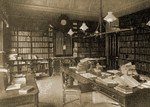
I’ve been using Accordance for about 6 years. Over that time, I’ve gradually developed my process for using Accordance for sermon preparation, which I’ve been asked to share with you. In the interest of space, I’ve not detailed every command involved. If you’re not sure how to do any of the things I mention, please ask in the comments, and I’ll provide more information.
Step One: Setting up the workspace
I’m part of a tradition that uses the Revised Common Lectionary (RCL), a set of four readings (usually Old Testament, Psalm, Gospel, New Testament) for each Sunday of the Christian Year, in a three year-cycle (Years A, B, and C.) Currently we are in Year A. For each Sunday, I use a workspace with two main zones. The first zone contains four text tabs: Old Testament, Psalm, Gospel, and New Testament. These are not search tabs, but text tabs originally created by clicking on a link. I then set up the panes the way I needed. (Generally the Greek or Hebrew Text and one or two English Translations)
The second zone contains tabs for several tools I use, including: RCL-A (a User Tool from Accordance Exchange that lists the Revised Common Lectionary readings for the Sundays in Year A) and Year A Notes (a User Tool I created to take notes on the readings for the Sundays in Year A).
Each week I open the workspace from the week before, set the Text tabs to this week’s readings, and save the workspace with a new name. The Zones feature has made this a lot easier for me, since I can see both the RCL-A tool and the tab I want to change at the same time.
Step Two: Translate My Preaching Text
While the RCL has four readings, I usually focus on only one reading for my sermon. Each week I translate the original language text (Hebrew or Greek) into English. These translations go into a special User Notes file. I set up the User Note Edit window to cover the English text pane in my main workspace, so I’m not relying on the English translation. If I need help with a word’s meaning, I can triple-click on it, and my chosen lexicon’s entry on the word will appear in my second zone.
As I’m translating, I highlight any words or phrases I want to explore more thoroughly later.
Step Three: Word Studies
If there are words that seem particularly important to me, I will do a word study. I have favorite workspaces set up for both Hebrew and Greek words. These workspaces search both the Biblical texts and my primary Greek or Hebrew Tools. I simply select the word I’m interested in, then amplify to the favorite workspace. I update my Year A Notes User Tool with any significant findings.
Step Four: Repeated words
Some weeks I’m struck by the repetition of one or more words in a reading. When this happens, I use Accordance to identify all the repeated words in a reading. When doing this, it’s important to remember to set the range in the Range drop-down, and not in the search box. [ed: For the differences between the range pop-up and the RANGE command, see this recent post] I have a special range called “temp” that I set to the current passage I’m working with. This way I’m not cluttering up my range list with all the lectionary readings over the course of a year.
For Greek searches, I keep the search syntax in a saved clipboard (using a third-party utility) and paste it into a new Greek search tab. For Hebrew searches, I open a saved workspace with the syntax for a search pre-entered. (My third-party clipboard utility doesn’t correctly handle the right-to-left direction necessary for Hebrew searches)
Again, I make notes in my User Tool.
Step Five: Other Accordance Resources
I usually check other resources within Accordance like the NET Notes, Comfort, and more recently the NIGTC commentary, adding notes to my User Tool as I go.
Step Six: Non-Accordance Resources
I typically also go to several on-line study resources and sometimes consult print resources. I enter notes from those into my User Tool as well. For on-line resources, I include a hyperlink to the web page, so I can return to the original if I need to.
Step Seven: Write the sermon
I write my sermon in NeoOffice. I consult Accordance as I go, but I don’t try to write my sermons in Accordance itself.

